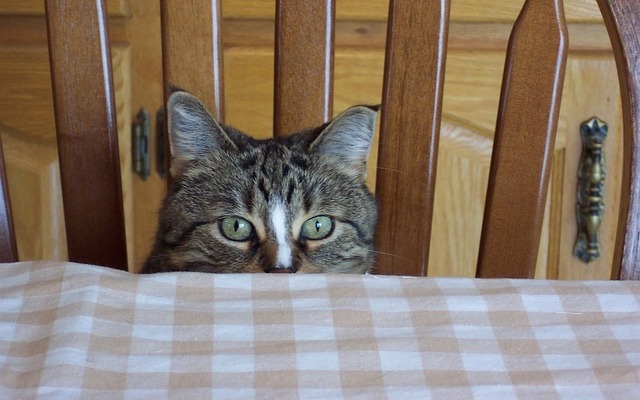As numerous hilarious Internet videos show, our cats seem to love to knock things off high places. Why do they engage in this funny — but also sometimes annoying or even dangerous — behavior?
Anyone who has cats knows they are very adept at using their paws. Watching cats play, you can see them bat at objects, paw at others and sometimes, with a twist of their little paws, hook items and toss them in the air. I know one feline patient who places his paws together to catch the little fake mouse toys that his owner tosses to him. Cats are also curious creatures, highly attracted by rapid movement. One of my cats is an expert flycatcher, while another will do somersaults in the air trying to catch the feather at the end of the fishing-pole toy. Knowing the nature of cats, it is not surprising when I hear people ask why their cats appear to enjoy knocking items off desks, tables, bookshelves, mantles, etc. I think a number of factors about this activity appeal to cats.
Part of the appeal may be linked to play-related behavior and the other part may be an expression of exploratory behavior. I think most cats start off just being curious about an object. They paw at the object to see if it moves or how it moves and inadvertently knock it off the desk. Once the cat has seen the object fall, he may be attracted by the speed of the falling object, the sound the object makes when it hits the floor and maybe even the attention, both good or bad, he receives from his owners.
That’s because, no matter what hits the ground, when we hear a noise, we all invariably come to see what happened. Some cats have learned that they can get our attention through this behavior. Sometimes the louder the bang, the quicker the owner’s response time. Sometimes watching the object fall and chasing after it on the floor is rewarding to the cat all by itself. While this can seem like big fun to your cat, it can be bothersome for you and can sometimes even be dangerous for the cat. For example, if a cat knocks over a glass object, he can injure his paws when he jumps on the floor and lands on or walks through the glass shards.
How to Redirect the Fun
If this behavior is a problem in your household, how can you stop your cat from doing this? The easy solution is to not leave anything on your desk, shelf, table, etc., that is light enough to be batted around and knocked over. Learn to live a minimalist life. Easier said than done, however! While you work on a solution for this issue, I do advise not leaving anything that is fragile on your table or shelves. If the problem area is limited to a single room, you can always try just closing the door and keeping kitty out. If that’s not possible, one quick option is to apply double-sided sticky tape to the desk, table or shelf. When your cat jumps on the table, his paws will stick a little to the tape and that sensation can deter most cats from jumping back on the table. If you can prevent your cat from jumping on the table, you will be more successful in stopping the problem.
If your cat has already jumped on the table, however, instead of getting up and yelling at him or chasing him away, make a noise to get his attention and redirect him to more appropriate behavior. The more positive techniques do take time but better provide your cat with appropriate outlets for mental and physical stimulation. Once you get your cat’s attention, you can give him something else to do, whether it is performing some behavior such as sit or come or chasing after a toy. Using clicker training to teach your cat fun activities and behavior can be very rewarding and will help keep him mentally engaged and out of trouble. Another way to redirect your cat is to give him a job. Use multiple puzzle toys and have him work for some of his food. Keep in mind that cats in the wild may spend 40 to 60 percent of their time hunting for food. Our cats who are kept in the home do not have enough activities to keep them engaged so they devise other ways to keep busy!
So, bottom line, your cat probably likes to play with your stuff because it’s fun. If you consider this behavior to be bothersome or dangerous, I’ve given you a few initial tips on how to try and redirect his attention. If you need additional advice, consult with your veterinarian, who may refer you to an animal behavior specialist.


